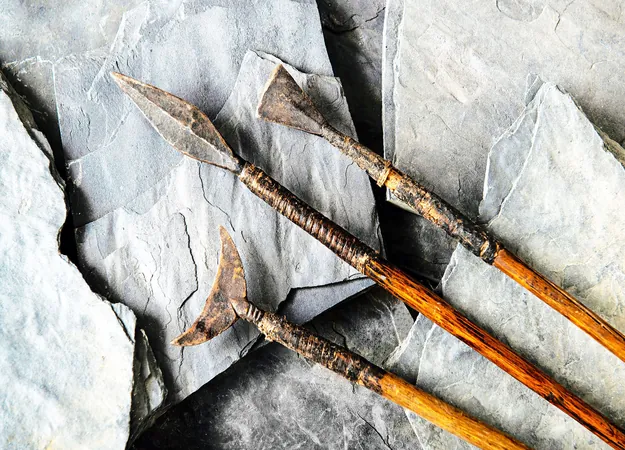
Revolutionary Flint Tool Unearthed: A Glimpse into Early Human Ingenuity!
2025-05-18
Author: Emily
Unraveling the Mysteries of Early Tool Use
Archaeology often resembles a detective's work, piecing together histories from tiny fragments. Every flint chip and bone shard unveils how our ancestors adapted, collaborated, and thrived in their environments. Recent discoveries from two significant sites near Tel Aviv, Jaljulia and Qesem Cave, shed exciting light on a transformative era in early human innovation.
A Game-Changer for Hunting and Tool Design
Dating back around 400,000 years, these findings reveal a pivotal shift: early Levantine hunters transitioned from hunting massive animals like elephants to sleeker prey, leading to groundbreaking advancements in tool design. The spotlight is on the Quina scraper, a specialized flint tool crafted for maximum efficiency.
This seemingly modest artifact, smaller than a smartphone, boasts a scalloped edge sharp enough to slice through muscle and hide with remarkable skill—akin to what you'd expect from a seasoned butcher.
From Giants to the Agile Fallow Deer
For nearly a million years, hunters thrived on large game. But as elephant populations dwindled, they were compelled to target fallow deer. These smaller animals provided significantly less meat, compelling hunters to adapt their strategies and tools to secure their sustenance.
Remains found in Jaljulia and Qesem Cave indicate a shift in diet corresponding to larger environmental changes in the late Lower Paleolithic era. The Quina scraper emerged as a response to this new hunting landscape, designed with a refined edge that allowed for rapid and precise butchering—keeping hunters safe from potential scavengers and predators.
Materials With Meaning: A Sacred Connection
Intriguingly, the raw material for these Quina scrapers came from over 12 miles away, sourced from the Samarian mountains, which also served as a calving ground for fallow deer. This geographical connection suggests that early humans were not only resource-savvy but also held a deep cultural awareness of their landscape.
Lead researchers Vlad Litov and Prof. Ran Barkai emphasize this connection, shedding light on how technological evolution corresponded with shifting dietary needs. The scrapers, characterized by their sharp, uniform edges, emerged to meet the complexities of processing fallow deer—a task requiring more skill and adaptability than butchering an elephant.
Cultural Significance Behind Tool Development
Beyond functionality, these tools symbolize a blend of practicality and perception. Early hunters seemed to recognize the profound relationship between their resources and the spiritual significance of the land. Just as modern societies revere certain landscapes, prehistoric peoples likely viewed the Samarian mountains as sacred spaces, linked not only to their sustenance but to their identities.
Lessons from the Past: Adaptation and Innovation
The findings at Jaljulia and Qesem Cave invite us to reflect on how early humans adapted to changing ecosystems and the challenges of resource scarcity. As megafauna disappeared, innovation blossomed, altering not just survival methods but the very fabric of their culture.
This humble flint scraper carries the legacy of human ingenuity—an artifact that represents much more than mere utility. It encapsulates the essence of what our ancestors valued, how they sustained themselves, and how they made sense of the world.
A Call to Reflection
This rich tapestry of adaptation speaks volumes in today's climate crisis, where ecosystems face unprecedented losses. The Quina scraper is more than just a tool; it’s a powerful reminder that every innovation is interwoven with cultural significance, shaping identities and survival.
Published in the journal Archaeologies, this study emphasizes that the past continues to inform our present—sustaining the narrative of human resilience and ingenuity.









 Brasil (PT)
Brasil (PT)
 Canada (EN)
Canada (EN)
 Chile (ES)
Chile (ES)
 Česko (CS)
Česko (CS)
 대한민국 (KO)
대한민국 (KO)
 España (ES)
España (ES)
 France (FR)
France (FR)
 Hong Kong (EN)
Hong Kong (EN)
 Italia (IT)
Italia (IT)
 日本 (JA)
日本 (JA)
 Magyarország (HU)
Magyarország (HU)
 Norge (NO)
Norge (NO)
 Polska (PL)
Polska (PL)
 Schweiz (DE)
Schweiz (DE)
 Singapore (EN)
Singapore (EN)
 Sverige (SV)
Sverige (SV)
 Suomi (FI)
Suomi (FI)
 Türkiye (TR)
Türkiye (TR)
 الإمارات العربية المتحدة (AR)
الإمارات العربية المتحدة (AR)